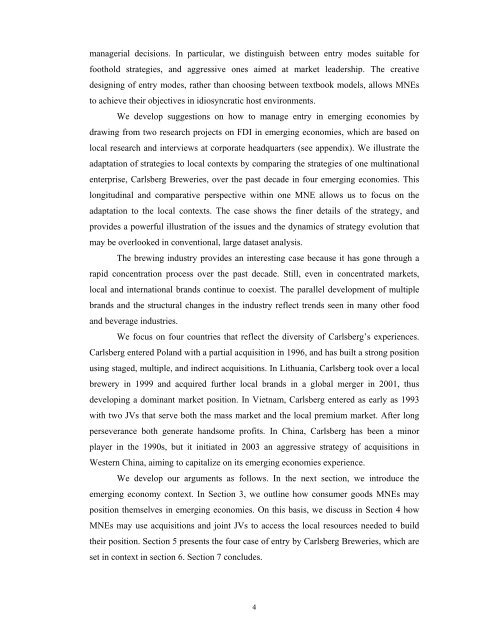Market Penetration and Acquisition Strategies for Emerging ...
Market Penetration and Acquisition Strategies for Emerging ...
Market Penetration and Acquisition Strategies for Emerging ...
You also want an ePaper? Increase the reach of your titles
YUMPU automatically turns print PDFs into web optimized ePapers that Google loves.
managerial decisions. In particular, we distinguish between entry modes suitable <strong>for</strong><br />
foothold strategies, <strong>and</strong> aggressive ones aimed at market leadership. The creative<br />
designing of entry modes, rather than choosing between textbook models, allows MNEs<br />
to achieve their objectives in idiosyncratic host environments.<br />
We develop suggestions on how to manage entry in emerging economies by<br />
drawing from two research projects on FDI in emerging economies, which are based on<br />
local research <strong>and</strong> interviews at corporate headquarters (see appendix). We illustrate the<br />
adaptation of strategies to local contexts by comparing the strategies of one multinational<br />
enterprise, Carlsberg Breweries, over the past decade in four emerging economies. This<br />
longitudinal <strong>and</strong> comparative perspective within one MNE allows us to focus on the<br />
adaptation to the local contexts. The case shows the finer details of the strategy, <strong>and</strong><br />
provides a powerful illustration of the issues <strong>and</strong> the dynamics of strategy evolution that<br />
may be overlooked in conventional, large dataset analysis.<br />
The brewing industry provides an interesting case because it has gone through a<br />
rapid concentration process over the past decade. Still, even in concentrated markets,<br />
local <strong>and</strong> international br<strong>and</strong>s continue to coexist. The parallel development of multiple<br />
br<strong>and</strong>s <strong>and</strong> the structural changes in the industry reflect trends seen in many other food<br />
<strong>and</strong> beverage industries.<br />
We focus on four countries that reflect the diversity of Carlsberg’s experiences.<br />
Carlsberg entered Pol<strong>and</strong> with a partial acquisition in 1996, <strong>and</strong> has built a strong position<br />
using staged, multiple, <strong>and</strong> indirect acquisitions. In Lithuania, Carlsberg took over a local<br />
brewery in 1999 <strong>and</strong> acquired further local br<strong>and</strong>s in a global merger in 2001, thus<br />
developing a dominant market position. In Vietnam, Carlsberg entered as early as 1993<br />
with two JVs that serve both the mass market <strong>and</strong> the local premium market. After long<br />
perseverance both generate h<strong>and</strong>some profits. In China, Carlsberg has been a minor<br />
player in the 1990s, but it initiated in 2003 an aggressive strategy of acquisitions in<br />
Western China, aiming to capitalize on its emerging economies experience.<br />
We develop our arguments as follows. In the next section, we introduce the<br />
emerging economy context. In Section 3, we outline how consumer goods MNEs may<br />
position themselves in emerging economies. On this basis, we discuss in Section 4 how<br />
MNEs may use acquisitions <strong>and</strong> joint JVs to access the local resources needed to build<br />
their position. Section 5 presents the four case of entry by Carlsberg Breweries, which are<br />
set in context in section 6. Section 7 concludes.<br />
4



